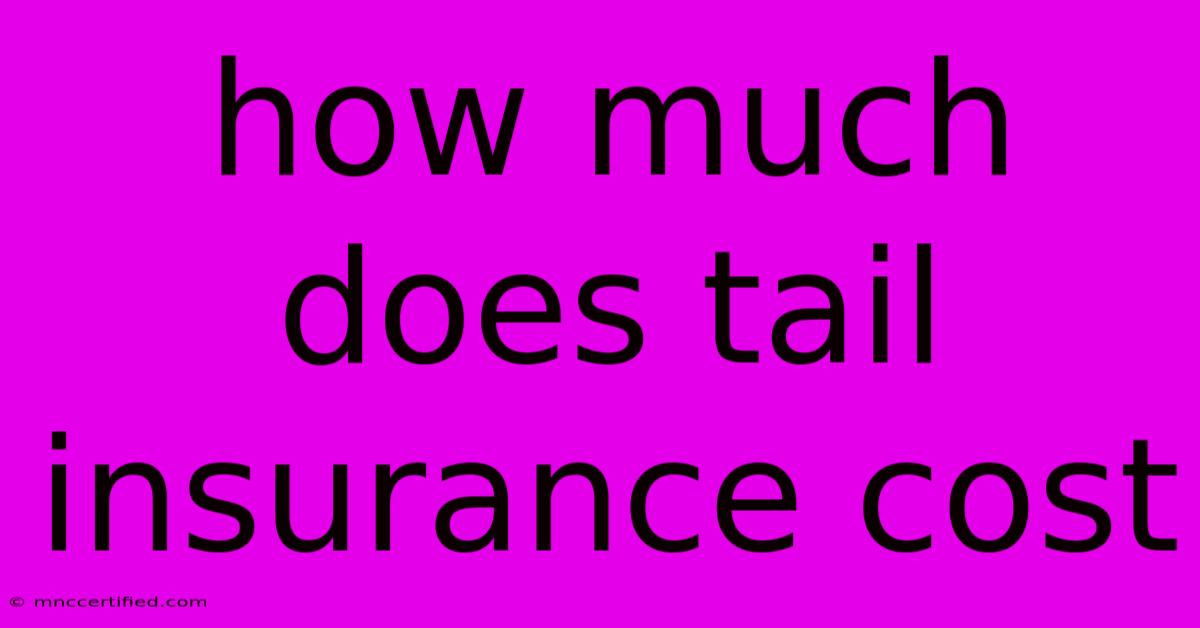How Much Does Tail Insurance Cost

Table of Contents
How Much Does Tail Insurance Cost? A Comprehensive Guide
Tail insurance, also known as "run-off" or "long-tail" insurance, is a crucial protection for businesses facing potential future liabilities stemming from past operations. But how much does it actually cost? The answer, unfortunately, isn't a simple number. The price of tail insurance is highly variable and depends on several key factors. This comprehensive guide will break down the cost drivers and help you understand what to expect.
Key Factors Determining Tail Insurance Costs
Several interconnected factors influence the premium you'll pay for tail insurance. Understanding these is critical to securing the best possible coverage at a reasonable price.
1. Type of Business and Industry:
The inherent risk associated with your business significantly impacts your premium. High-risk industries like manufacturing, pharmaceuticals, and construction typically face higher premiums due to the greater potential for long-term liabilities. Professional services like law firms and accounting firms also often require tail insurance, with costs varying based on specialization and past claims history.
2. Claims History:
Your past claims experience is a major determinant. A history of numerous or significant claims will significantly increase your premium. Insurers view a clean claims history as a lower risk, resulting in more favorable pricing. Proactive risk management strategies can help minimize claims and, consequently, lower insurance costs.
3. Policy Limits and Coverage Period:
The higher the policy limits (the maximum amount the insurer will pay for covered claims), the higher the premium. Similarly, the longer the coverage period (the length of time the insurance protects against future claims), the more expensive the policy will be. Carefully considering your needs and risk assessment is key to selecting appropriate limits and duration.
4. Insurer Selection:
Different insurers have different risk appetites and pricing models. Comparing quotes from multiple reputable insurers is crucial to finding the most competitive pricing. Look beyond just the premium; consider the insurer's financial strength and reputation for claims handling.
5. Policy Deductible:
Choosing a higher deductible will generally lower your premium. However, this means you'll bear more of the cost if a claim arises. Carefully weigh the trade-off between premium savings and potential out-of-pocket expenses.
6. Geographic Location:
The location of your business can also influence the cost. Areas with higher legal costs or a greater frequency of claims may lead to higher premiums.
Estimating the Cost: A Range, Not a Fixed Number
Due to the complexities mentioned above, it's impossible to provide a precise figure for tail insurance costs. However, you can expect premiums to range from a few thousand dollars to several million dollars, depending on the factors described. For smaller businesses with limited liabilities and a clean claims history, the cost might be relatively low. Conversely, large corporations in high-risk sectors with a history of claims could face substantially higher premiums.
Finding the Right Tail Insurance: Expert Advice is Key
Securing appropriate tail insurance is a complex process. Engaging with a qualified insurance broker is highly recommended. A broker can help you:
- Assess your risk profile accurately.
- Compare quotes from multiple insurers.
- Negotiate favorable terms and conditions.
- Understand the policy's intricacies.
Don't underestimate the importance of proper insurance planning. Tail insurance offers vital protection against potentially devastating future liabilities. By understanding the factors that influence cost and working with a knowledgeable broker, you can secure the right coverage at a price that aligns with your budget and risk tolerance.
Keywords: Tail Insurance Cost, Run-off Insurance, Long-tail Insurance, Professional Liability Insurance, Claims History, Insurance Premiums, Risk Assessment, Insurance Broker, Policy Limits, Deductible
(Note: This article provides general information and should not be considered financial or legal advice. Consult with qualified professionals for personalized guidance.)

Thank you for visiting our website wich cover about How Much Does Tail Insurance Cost. We hope the information provided has been useful to you. Feel free to contact us if you have any questions or need further assistance. See you next time and dont miss to bookmark.
Featured Posts
-
Jolies Chic Night Out Look
Nov 19, 2024
-
Daikin Park Astros New Stadium Name
Nov 19, 2024
-
Cardona Travel And Insurance Agency
Nov 19, 2024
-
Daikin Park Astros Rename Minute Maid Park
Nov 19, 2024
-
M4 Bridge Traffic Stopped Pothole Repairs
Nov 19, 2024